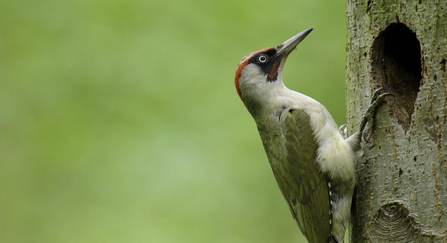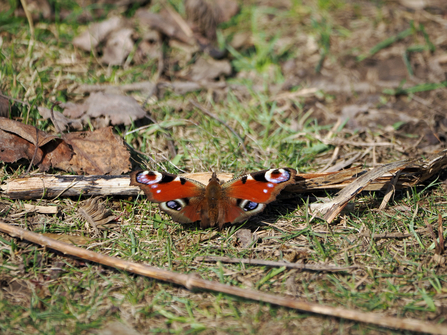Green woodpeckers are something of a paradox: like jays, they’re shy birds whose natural reticence is undermined by their gaudy plumage and tendency to guffaw like an over-enthusiastic fan at a comedy gig.
Snap, cackle and flop: trying to photograph laughing green woodpeckers at Barlow Common
Barlow Common (C) Rod Jones

Green woodpecker by Andrew Mason
They’re often heard but much more rarely seen. If you are going to try and spot them, though, this gem of a reserve near Selby is one of the best places in Yorkshire to do it.
By early afternoon, after five hours of clandestine cackling, I’ve accepted that the woodpeckers are going to have the last laugh. But suddenly there’s a loud burst of yaffling and a bird swoops into a tall silver birch about 15 metres from where I’m standing. I edge forward, desperate to find a decent angle for photos, but I’ve been spotted: with a derisory laugh, the woodpecker flies off into the trees.
I flick through the few images I’ve managed to grab: blurry shots of an olive-green wing, scarlet crown and pale breast just visible through a tangle of twigs. I’ve come tantalisingly close, and I’ll return soon to have another try at capturing some proper images of these strikingly beautiful birds.
Long-tailed tit (C) Rod Jones
Green woodpeckers may be the jewel in Barlow Common’s crown, but there’s a wealth of other, less elusive, wildlife to enjoy in the rich mosaic of habitats provided by this former rubbish tip – like the gorgeous long-tailed tit hopping around in a bramble bush near the car park and looking earnestly into my lens.
I watch a kestrel having a brief aerial spat with a carrion crow, before twisting away and scornfully soaring off into the wide blue yonder.
On the ground, I catch a brief glimpse of an animal with a long tail running across the path before vanishing among the teasel plants. It’s smaller than a fox and its tail isn’t bushy like a squirrel’s, so it’s probably a stoat – one of the wildlife highlights that visitors are urged to look out for.
In the far corner of the reserve, a grey heron stands in the middle of a reed-fringed pond. I track the big bird through my long lens as it takes flight and flaps lazily above the trees. As the heron heads into the distance, I find my camera pointing at a surprisingly close view of Selby Abbey – a reminder that Barlow Common may be wild, but it isn’t remote.
Gorse bush (C) Rod Jones
Everywhere I go, there are signs of spring. Vivid green leaves are bursting out on hawthorn trees. I’m startled by a brilliant patch of gorse flowers growing among the rusty uniformity of a bramble thicket, like a splash of bright yellow paint in a scrapyard.
There are still some reminders of winter, though. A bird flies across and perches high in a silver birch. Its white eye stripe identifies it as a redwing, a type of thrush that spends the winter in the UK. It seems strangely out of place on such a warm day: in a week or two it’ll be leaving our shores and heading to Scandinavia to breed.
While the winter thrushes get ready for departure, some of the earliest summer visitors have already arrived from North Africa and southern Europe. The woods are filled with the song of chiffchaffs – a monotonous noise that sounds as if the birds are repeating their own name over and over again. I spot several of these little leaf warblers broadcasting proudly from the treetops.
Female linnet (C) Rod Jones
It’s nest-building season: a pair of linnets flit around among the brambles, and when the female pauses to perch on a thorny branch, I discover that she’s got a twig clamped in her beak.
Away from the main footpath, down a quiet, grassy path bathed in sunlight, I come across one of the most heartening signs of spring. It flies towards me at head height with strong wing beats, too small to be a bird. As it sails past, I realise it’s a peacock butterfly.

Peacock butterfly (C) Rod Jones
I hastily turn round and follow it until it lands on the ground, giving me a chance to admire its beautiful palette of deep red, gold, black, white, blue and brown, with the distinctive “eye” pattern on its wings.
As the day warms up, more peacocks appear. There are brimstones too, their wings glinting yellow in the sunlight. I never see this species in my home patch in West Yorkshire, and I’d love to photograph one, but they flutter about restlessly, refusing to settle long enough for me to get a shot.
There’s a third type of butterfly around: the comma, sporting an orange upperwing with black spots and a dark brown underside that looks just like a dead leaf. I spot one landing, so I lie down flat on the grass to get a better angle for a photo.
After a minute or two, it dawns on me that the comma has made a sneaky exit and the perfectly camouflaged “butterfly” I’m snapping away at is in fact a dead leaf. A tad embarrassed, I haul myself to my feet and dust myself down.
Is that the sound of cackling laughter I can hear?
Where to spot green woodpeckers
As well as Barlow Common, listen out and keep your eyes peeled for green woodpeckers at Allerthorpe Common, Hollinhurst Wood and Adel Dam in West Yorkshire, Strensall Common in North Yorkshire, Cali Heath in East Yorkshire and Birch Wood nature reserve in the North York Moors.

